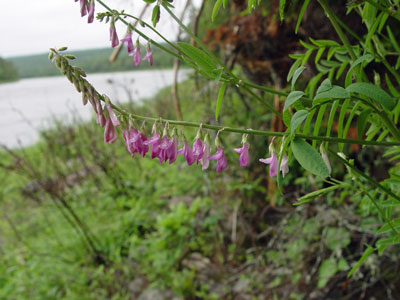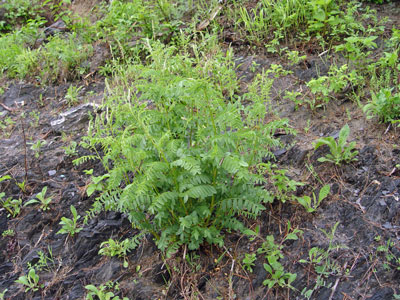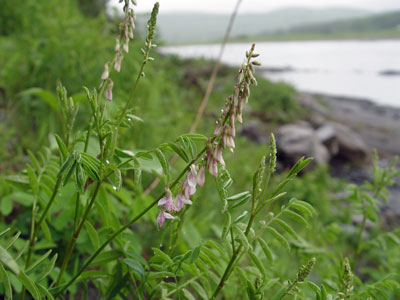DACF Home → Bureaus & Programs → Maine Natural Areas Program → Communities, Plants, and Animals → Rare Plants → Hedysarum alpinum

Hedysarum alpinum L. ssp. americanum (Michx.) Fedtsch.
Alpine Sweet-broom
- State Rank: S3
- Global Rank: G5T5?
- State Status: Special Concern
Habitat: Calcareous river gravels and ledges. [Non-tidal rivershore (non-forested, seasonally wet)]
Range: Newfoundland to Alaska, south to northern New Brunswick, northern Maine, sporadically west to British Columbia.
Aids to Identification: Alpine sweet-broom can be recognized by its upright habit (standing up to 1 m high), its typically pea-like leaves which are up to 20 cm long and divided into 13-25 oblong leaflets, and, when flowering, by its elongated, one-sided cluster (raceme) of small, magenta, pea-like flowers. The raceme is usually narrow and longer than the leaves. In fruit, the plant bears small pods, constricted in one or more places, that disarticulate into 1-seeded segments.

Ecological characteristics: Hedysarum alpinum grows in calcareous ledges or gravels, often along rivers where the surroundings are periodically disturbed. The populations, at least in Maine, are scattered and usually not extensive. Alpine sweet-broom often grows on the upper portions of river shores and is associated with plants such as Allium schoenoprasum var. sibiricum, Prunus pumila var. depressa, Tanacetum huronense, and common grasses and shrubs.
Phenology: Herbaceous perennial, flowering in July in Maine, pods maturing late August.
Family: Fabaceae

Synonyms: Hedysarum alpinum L. var. americanum Michx.; Hedysarum americanum (Michx.) Britt.
Known Distribution in Maine: This rare plant has been documented from a total of 16 town(s) in the following county(ies): Aroostook.
Reason(s) for rarity: At southern limit of range, and habitat naturally scarce. Habitat may be threatened by hydropower development.
Conservation considerations: Maintain hydrologic integrity of its rivershore habitat, including natural disturbance by water and ice. Populations could be harmed if all-terrain vehicle use of its habitat increases.